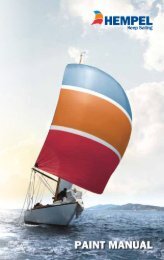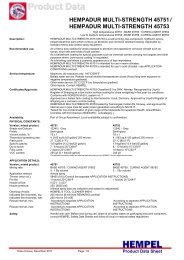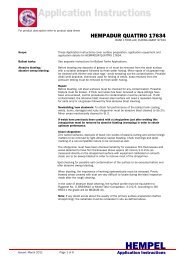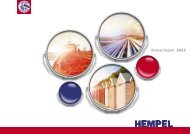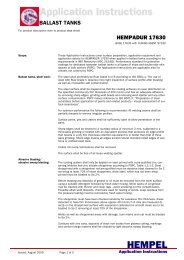Product Data Sheet - Hempel
Product Data Sheet - Hempel
Product Data Sheet - Hempel
- TAGS
- hempel
- hempel.com
You also want an ePaper? Increase the reach of your titles
YUMPU automatically turns print PDFs into web optimized ePapers that Google loves.
Description:<br />
Recommended use:<br />
Service temperature:<br />
Availability:<br />
PHYSICAL CONSTANTS:<br />
<strong>Product</strong> <strong>Data</strong><br />
HEMPEL'S POLYESTER GF 35920<br />
HEMPEL’S POLYESTER GF 35920 is a high solid, two-component heavy duty lining system based on<br />
isophthalic polyester acrylic copolymer reinforced with glass flakes.<br />
Applicable in thick coats by standard heavy duty airless spray equipment.<br />
As rust preventing coating for areas exposed to high abrasion and impact.<br />
As rust preventing coating for areas requiring short interval between application and seawater<br />
immersion - 6 hours at 20°C/68°F is required.<br />
Maximum, dry exposure only: 140°C/284°F<br />
In water (maximum temperature gradient 35°C/63°F): 80°C/176°F<br />
Part of Group Assortment. Local availability subject to confirmation.<br />
35920 : BASE 35929 : Hardener 99020<br />
Shade nos/Colours:<br />
Finish: Flat<br />
Volume solids, %: 90 see REMARKS overleaf.<br />
Theoretical spreading rate: 1.4 m<br />
The physical constants stated are nominal data according to the HEMPEL Group's approved formulas.<br />
2 11630* / Off-white.<br />
/l [56.1 sq.ft./US gallon] - 650 micron/26 mils<br />
Flash point:<br />
26 °C [78.8 °F]<br />
Specific gravity:<br />
1.1 kg/litre [9.2 lbs/US gallon]<br />
Dry to touch: 4 approx. hour(s) 20°C/68°F<br />
Fully cured: 7 day(s) 20°C/68°F<br />
VOC content:<br />
446 g/l [3.7 lbs/US gallon]<br />
Shelf Life: 6 months (25°C/77°F) from time of production.<br />
Shelf life is dependent on storage temperature. Shelf life is reduced at storage temperatures above<br />
25°C/77°F. Do not store above 40°C/104°F.<br />
-<br />
*other shades according to assortment list.<br />
-<br />
APPLICATION DETAILS:<br />
Version; mixed product: 35920<br />
Mixing ratio:<br />
BASE 35929 : Hardener 99020<br />
98.5 : 1.5 By volume<br />
Application method: Airless spray / Brush/Roller<br />
According to separate APPLICATION INSTRUCTIONS<br />
Thinner (max.vol.):<br />
Do not dilute. According to separate APPLICATION INSTRUCTIONS<br />
Pot life:<br />
45 minute(s) 20°C/68°F According to separate APPLICATION INSTRUCTIONS<br />
Nozzle orifice: 0.03 - 0.06 " Reversible<br />
Nozzle pressure: 275 bar [3987.5 psi]<br />
(Airless spray data are indicative and subject to adjustment)<br />
Styrene, methyl ethyl ketone. According Cleaningto of separate tools: APPLICATION INSTRUCTIONS<br />
Indicated film thickness, dry: 650 micron [26 mils]<br />
Indicated film thickness, wet: 725 micron [29 mils]<br />
Recoat interval, min: According to separate APPLICATION<br />
INSTRUCTIONS<br />
Recoat interval, max: According to separate APPLICATION<br />
INSTRUCTIONS<br />
Safety: Handle with care. Before and during use, observe all safety labels on packaging and paint containers,<br />
consult HEMPEL Safety <strong>Data</strong> <strong>Sheet</strong>s and follow all local or national safety regulations.<br />
Date of issue: January 2012<br />
-<br />
Page: 1/2<br />
<strong>Product</strong> <strong>Data</strong> <strong>Sheet</strong>
HEMPEL'S POLYESTER GF 35920<br />
SURFACE PREPARATION: New steel: Remove oil and grease etc. thoroughly with suitable detergent. Remove salts and other<br />
contaminants by high pressure fresh water cleaning. Abrasive blasting to near white metal Sa 2½ (ISO<br />
8501-1:1988) with a surface profile corresponding to Rugotest No. 3, BN10a, Keane-Tator Comparator<br />
3.0 G/S, or ISO Comparator Rough Medium (G). After blasting, clean the surface carefully from<br />
abrasives and dust.<br />
Repair and maintenance: Remove oil and grease etc. thoroughly with suitable detergent. Remove<br />
salts and other contaminants by high pressure fresh water cleaning. On pit-corroded surfaces,<br />
excessive amounts of salt residues may call for high pressure water jetting, wet abrasive blasting,<br />
alternatively dry abrasive blasting, high pressure fresh water hosting, drying, and finally dry abrasive<br />
blasting again.<br />
Galvanized, Zinc primed steel etc.: Metallic zinc inhibits the curing process - the product is not<br />
compatible with galvanized steel or other zinc coated substrates. Steel primed with zinc dust containing<br />
pre-fabrication primers must be re-blasted to min. Sa 2½-3 to remove all traces of zinc.<br />
APPLICATION CONDITIONS: Apply only on a dry and clean surface with a temperature above the dew point to avoid condensation.<br />
Use only where application and curing can proceed at temperatures above: 10°C/50°F. Maximum<br />
relative humidity: 85%. In-can temperature of the paint should preferably be below 25°C/77°F and<br />
above 15°C/59°F. In confined spaces provide adequate ventilation during application and drying.<br />
See separate APPLICATION INSTRUCTIONS<br />
PRECEDING COAT<br />
SUBSEQUENT COAT:<br />
REMARKS:<br />
None.<br />
None, or as per specification. Recommended systems are: solvent borne coating<br />
Film thicknesses/thinning: May be specified in another film thickness than indicated depending on purpose and area of use. This<br />
will alter spreading rate and may influence drying time and recoating interval. Normal range dry is: 650-<br />
750 micron/26-30 mils.<br />
Absolute minimum is: 500 micron/20 mils.<br />
Maximum not more than 1250 micron/50 mils.<br />
Volume solids, %:<br />
Theoretically, the products contains 100% solid. Depending on the application and curing conditions<br />
some of the volatile reactants may evaporate. Furthermore, the curing process is accompanied by a<br />
contraction.<br />
These two factors result in a “theoretical” volume solids of 90% and a spreading rate of 1.4 m²/l at<br />
650 micron (56 sq.ft./US gallon).<br />
By unfavourable application conditions, higher losses may result in a practical spreading rate of<br />
approximately1.2 m²/l at 650 micron. The curing is, however, not affected by a higher loss.<br />
Nota:<br />
HEMPEL'S POLYESTER GF 35920 For professional use only.<br />
ISSUED BY: HEMPEL A/S 3592011630<br />
This <strong>Product</strong> <strong>Data</strong> <strong>Sheet</strong> supersedes those previously issued.<br />
For explanations, definitions and scope, see “Explanatory Notes” available on www.hempel.com. <strong>Data</strong>, specifications, directions and recommendations given in this data sheet represent only test results<br />
or experience obtained under controlled or specially defined circumstances. Their accuracy, completeness or appropriateness under the actual conditions of any intended use of the <strong>Product</strong>s herein<br />
must be determined exclusively by the Buyer and/or User.<br />
The <strong>Product</strong>s are supplied and all technical assistance is given subject to HEMPEL's GENERAL CONDITIONS OF SALES, DELIVERY AND SERVICE, unless otherwise expressly agreed in writing.<br />
The Manufacturer and Seller disclaim, and Buyer and/or User waive all claims involving, any liability, including but not limited to negligence, except as expressed in said GENERAL CONDITIONS for all<br />
results, injury or direct or consequential losses or damages arising from the use of the <strong>Product</strong>s as recommended above, on the overleaf or otherwise. <strong>Product</strong> data are subject to change without notice<br />
and become void five years from the date of issue.<br />
Date of issue: January 2012<br />
-<br />
Page: 2/2<br />
<strong>Product</strong> <strong>Data</strong> <strong>Sheet</strong>



